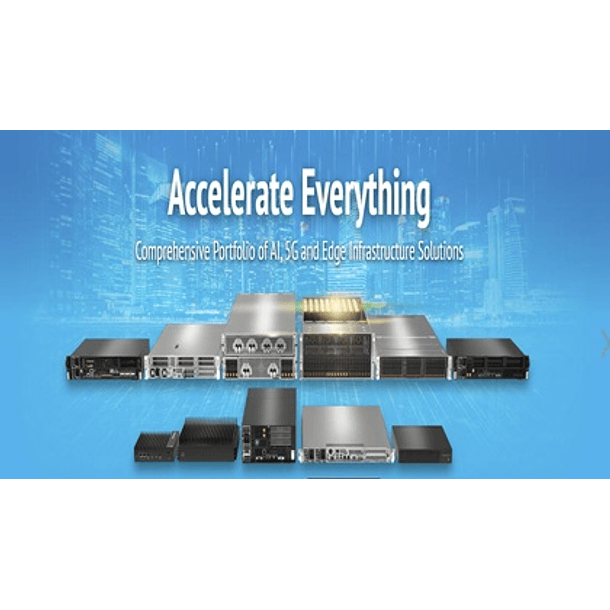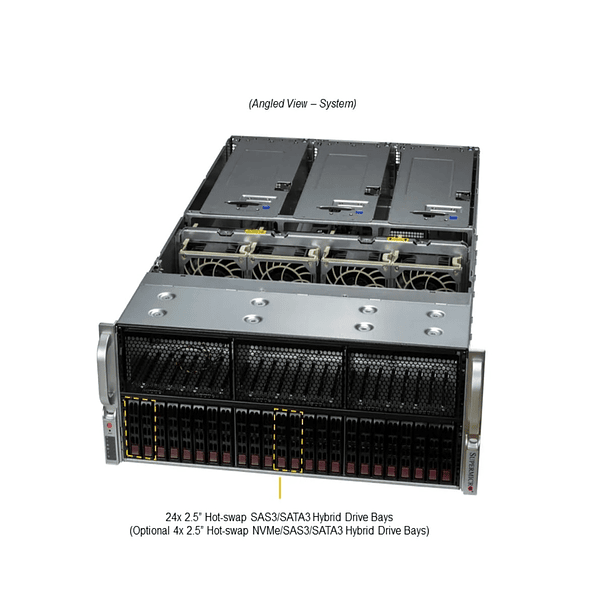Total Cost of Ownership (TCO) Savings with Twin Servers
To illustrate the Total Cost of Ownership (TCO) savings with Supermicro Twin servers, consider a comparison scenario between a traditional single-node 1U server solution and an equivalent solution with Supermicro Twin servers.
Scenario: A company needs to deploy 80 compute nodes for its data virtualization and analytics applications.
Option 1: Traditional 1U servers (one node per chassis)
- Servers: 80 individual 1U servers.
- Rack Space: 80 rack units (U).
- Power Supplies: 80 redundant power supplies (one per server).
- Fans: 80 fan assemblies (one per server).
- Cabling: Large number of network and power cables (80 power cables, 80 main network cables, etc.).
- Power Consumption: Increased consumption due to the duplication of management components (power supplies, fans) on each individual server.
- Cooling: Increased heat generation and therefore increased cooling requirements in the data center.
- Maintenance: More individual points of failure and increased complexity in cable management.
Option 2: Supermicro BigTwin Servers (4 nodes in 2U)
- Servers: 20 BigTwin chassis (20 x 4 nodes = 80 nodes).
- Rack Space: 20 chassis x 2U = 40 rack units (U).
- Power Supplies: 40 redundant power supplies (two per BigTwin chassis, shared between 4 nodes).
- Fans: 20 fan assemblies (one per chassis, shared between 4 nodes).
- Cabling: Fewer cables (20 main power cables, 20 main network cables, etc., plus internal cables for each node).
- Power Consumption: Significant reduction in power consumption by sharing power supplies and fans between multiple nodes. Power supply efficiency is also optimized by operating at a higher, more constant load.
- Cooling: Lower heat generation per computing unit and improved airflow within the consolidated chassis, reducing cooling costs.
- Maintenance: Fewer chassis to manage, hot-swap nodes allow for maintenance without disruption to other nodes in the same chassis, simplifying operations.
TCO Savings Example (estimated):
Cost Factor | Traditional 1U Servers (80 nodes) | Supermicro BigTwin Servers (80 nodes) | Estimated Annual Savings |
Rack Space | 80U | 40U | 50% reduction in rack space. This translates into fewer square meters of data center space required or the ability to house more equipment in the same space, which can mean significant savings in rent or construction costs. |
Energy Consumption | Higher (e.g. 80 x 500W = 40kW) | Lower (e.g. 20 x 1500W = 30kW) | ~25% energy savings (depending on configuration and workload). If the energy cost is $0.15/kWh, a 10kW saving translates to $1.50/hour, or approximately $13,140 per year. |
Refrigeration | Elderly | Minor | ~20-30% savings in cooling costs due to reduced heat generation and improved thermal design. This can be comparable to energy savings. |
Cabling | High (80 power cords, etc.) | Low (20 power cables, etc.) | Reduction in cable purchase costs and installation time. |
Hardware (initial) | It may be similar per node, but the total cost of individual chassis and power supplies is higher. | The cost per node may be slightly higher initially, but this is offset by the reduced chassis and power supplies. | Savings on the purchase of shared components. |
Maintenance and Operations | Greater complexity, more points of failure. | Lower complexity, hot-swap nodes. | Reduction in labor hours for installation, configuration, and maintenance. Fewer service interruptions. |
Conclusion of Savings in TCO:
TCO savings with Supermicro Twin servers are achieved primarily through:
- Reduction in physical space: By requiring fewer rack units, data center utilization is optimized.
- Lower energy consumption: Component consolidation and efficient design reduce electricity bills.
- Lower cooling costs: Less heat generation means less energy is required to maintain the optimal temperature.
- Simplified cabling: Fewer cables mean lower hardware costs and less installation and management time.
- Increased operational efficiency: The ease of maintenance and high availability of hot-swap nodes reduce labor costs and the impact of outages.
While the initial cost per node may be similar or even slightly higher in some Twin configurations, the cumulative savings in power, cooling, space, and operations over the life of the equipment make Supermicro Twin servers a much more cost-effective long-term investment for workloads requiring high density and performance.
Supermicro Twin servers are an excellent choice when looking to maximize compute density and performance in a limited space , while optimizing energy efficiency. Here's when to recommend using them:
1. Space and Power Constrained Environments (Data Centers and Colocation):
- High Density: Twin servers group multiple nodes (full servers) into a single chassis, sharing power supplies and fans. This allows the number of servers to be doubled or quadrupled in the same rack space, ideal for data centers with limited space.
- Energy Efficiency: By sharing components and optimizing airflow, Twin systems reduce energy consumption and cooling costs, lowering Total Cost of Ownership (TCO).
2. High Performance Computing (HPC) and Big Data Applications:
- Compute-Intensive: Individual nodes within a Twin chassis can be configured with powerful CPUs (latest-generation Intel Xeon Scalable processors), large memory capacities, and fast storage options (NVMe), making them ideal for demanding workloads such as scientific simulations, complex data analysis, and financial modeling.
- Parallel Processing: Multi-node architecture facilitates the implementation of clusters for parallel computing, where multiple nodes work together to solve complex problems.
3. Hyperconverged Infrastructure (HCI) and Virtualization:
- Simple Scalability: The ability to scale horizontally by adding more nodes within the same chassis makes Twins ideal for HCI solutions, where compute, storage, and networking are consolidated onto a single platform.
- Resource Optimization: Enables efficient resource utilization in virtualized environments, supporting multiple virtual machines per node and optimizing CPU and memory usage.
4. Cloud Service Providers (CSP) and Web Hosting:
- Rapid and Scalable Deployment: Its modular design and high density make it easy for cloud service providers to offer scalable infrastructure to their customers.
- Operational Efficiency: Ease of maintenance (with hot-swap nodes) and built-in redundancy ensure high availability and reduce downtime.
5. AI and Machine Learning Applications:
- While Twin servers are primarily CPU-based, some configurations can include GPU options, making them useful for AI and machine learning workloads that require high compute density.
6. When High Availability and Ease of Maintenance are Required:
- Redundancy: Twin systems typically include redundant power supplies and hot-swap nodes, allowing component replacement without shutting down the entire chassis, minimizing downtime.
In short, Supermicro Twin servers are the ideal solution when density, energy efficiency, performance, and scalability are key priorities for your IT infrastructure, especially in environments where space is at a premium. Supermicro offers different Twin families (such as BigTwin, TwinPro, FatTwin, and GrandTwin), each optimized for specific needs, from liquid cooling solutions to configurations with large NVMe storage capacities.
Remember that for Chile, Super Latam is the most important authorized Supermicro distributor, and they can help you with specific configurations.
Supermicro Twin servers are an excellent choice when looking to maximize compute density and performance in a limited space , while optimizing energy efficiency. Here's when to recommend using them:
1. Space and Power Constrained Environments (Data Centers and Colocation):
- High Density: Twin servers group multiple nodes (full servers) into a single chassis, sharing power supplies and fans. This allows the number of servers to be doubled or quadrupled in the same rack space, ideal for data centers with limited space.
- Energy Efficiency: By sharing components and optimizing airflow, Twin systems reduce energy consumption and cooling costs, lowering Total Cost of Ownership (TCO).
2. High Performance Computing (HPC) and Big Data Applications:
- Compute-Intensive: Individual nodes within a Twin chassis can be configured with powerful CPUs (latest-generation Intel Xeon Scalable processors), large memory capacities, and fast storage options (NVMe), making them ideal for demanding workloads such as scientific simulations, complex data analysis, and financial modeling.
- Parallel Processing: Multi-node architecture facilitates the implementation of clusters for parallel computing, where multiple nodes work together to solve complex problems.
3. Hyperconverged Infrastructure (HCI) and Virtualization:
- Simple Scalability: The ability to scale horizontally by adding more nodes within the same chassis makes Twins ideal for HCI solutions, where compute, storage, and networking are consolidated onto a single platform.
- Resource Optimization: Enables efficient resource utilization in virtualized environments, supporting multiple virtual machines per node and optimizing CPU and memory usage.
4. Cloud Service Providers (CSP) and Web Hosting:
- Rapid and Scalable Deployment: Its modular design and high density make it easy for cloud service providers to offer scalable infrastructure to their customers.
- Operational Efficiency: Ease of maintenance (with hot-swap nodes) and built-in redundancy ensure high availability and reduce downtime.
5. AI and Machine Learning Applications:
- While Twin servers are primarily CPU-based, some configurations can include GPU options, making them useful for AI and machine learning workloads that require high compute density.
6. When High Availability and Ease of Maintenance are Required:
- Redundancy: Twin systems typically include redundant power supplies and hot-swap nodes, allowing component replacement without shutting down the entire chassis, minimizing downtime.
In short, Supermicro Twin servers are the ideal solution when density, energy efficiency, performance, and scalability are key priorities for your IT infrastructure, especially in environments where space is at a premium. Supermicro offers different Twin families (such as BigTwin, TwinPro, FatTwin, and GrandTwin), each optimized for specific needs, from liquid cooling solutions to configurations with large NVMe storage capacities.
Remember that for Chile, Super Latam is the most important authorized Supermicro distributor, and they can help you with specific configurations.

















